Featured
Behavioral Insights in the Global South
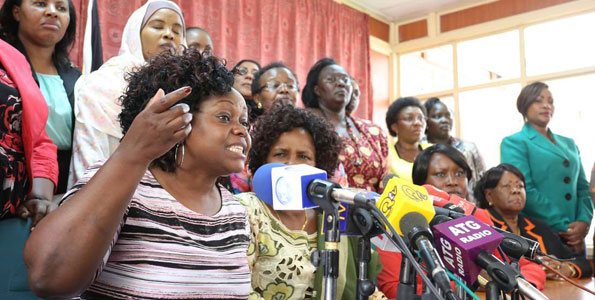
Above: Speeches are a relatively normal part of life in Kenya, where a study using the Trier Social Stress Test proved “miserably suited.” Image courtesy of the Busara Lab.
More than 80% of the world’s population lives in countries other than the United States, Canada, and Europe, which dominate psychological science nonetheless. The Global Spotlight series is a small step toward closing that gap. Authors across the globe—including in regions that have long been underrepresented in the research community—share unique and personal perspectives on the issues affecting their work and careers. In providing these on-the-ground narratives, we hope to illuminate concrete challenges and opportunities alike involving this truly global science.
Busara’s field surprise • Save the Children medical incidence reporting • IRC social and emotional learning activities in North-East Nigeria • Risks and challenges of behavioral insights in the Global South • Metascience and the future of behavioral insights in the Global South
Why do people, even those at most risk, refuse to take the COVID vaccine? How does one increase children’s handwashing behaviors in vulnerable settings? What are the best ways to increase proenvironmental behaviors, especially in populations that will benefit most? In recent years, applied behavioral science (also often called behavioral insights) has emerged as a field that combines findings from psychology, behavioral economics, and other social sciences to answer these kinds of questions—that is, to explain why people behave the way they do. Whenever a problem involves human behavior, behavioral insights have the potential to help, especially when they were generated through a rigorous scientific process.
Popularized by the concept of “nudge units” in the United States and the United Kingdom, which were charged with using behavioral principles to expand the usefulness of nonprofit, industry, and government programs, behavioral science has since expanded to a host of other countries, including Canada, Australia, India, and Singapore (Afif, 2017). Most behavioral science teams today are within the for-profit sector, and many prominent organizations (such as Meta and Apple) have dedicated behavioral science teams. However, there are nearly five times as many behavioral science teams located in the Global North than the Global South (Action Design Network, n.d.). This concentration results in evidence, perspectives, and approaches disproportionately produced by and for contexts in the Global North (Forscher et al., 2021; Henrich et al., 2010a; IJzerman et al., 2021).
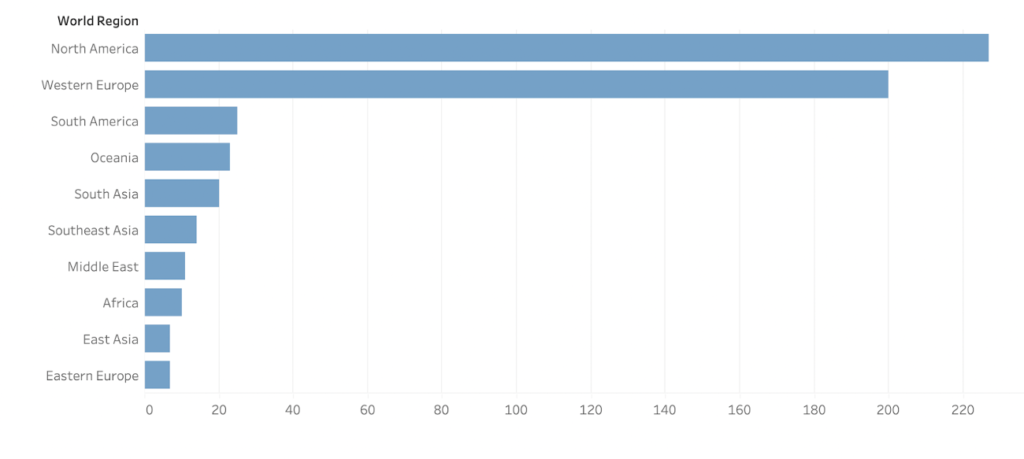

Given this disparity, the Global South is well poised to change this narrative by developing and applying locally informed behavioral science approaches and generating local knowledge that can then inform and benefit behavioral science as a whole (Adetula et al., 2022; Mughogho et al., 2023). Applied behavioral science also stands to improve development and humanitarian programs, which have been traditionally critiqued as insufficiently sensitive to the needs and preferences of their ultimate beneficiaries (Reimann, 2005). Applied behavioral science offers a toolkit for understanding those very needs and preferences to develop a locally informed science.
Several organizations have pioneered this approach, including those where the authors work: the Center for Utilizing Behavioral Insights for Children (CUBIC), hosted by Save the Children International; the United Nations Children’s Fund (UNICEF), whose Global Office of Research and Foresight (Innocenti) has established a network of multidisciplinary Behavioral Insights Research and Design (BIRD) Laboratories; the Busara Center for Behavioral Economics (Busara); and the International Rescue Committee (IRC). Their efforts have focused on applied behavioral science in the Global South, mostly in development and humanitarian contexts. The Annecy Behavioral Science Lab (ABSL) is a metascience startup that connected the authors and organizations that contributed to this piece.
What has been done so far? These organizations have tested interventions aimed at increasing various behaviors, for example, handwashing in elementary schools in the Philippines (UNICEF, 2022), measles immunization in Lebanon (Balsom, 2019), screening for childhood malnutrition in Mali (Lopez et al., 2022), engaging refugee parents in their children’s development (Wilton et al., 2017), and medical incidence reporting in refugee camps in Bangladesh and Rwanda (CUBIC, 2023). Other interventions have aimed to, for example, enhance food security, well-being, and earnings for low-income families in Kenya (Haushofer & Shapiro, 2016) and improve loan repayment rates in Nigeria (Busara, 2022).
UNICEF, CUBIC, IRC, and Busara also extensively partner with local government units, private companies, and nonprofits to provide behavioral insights on projects relating to child protection and well-being, nutrition, immunization, child development, gender equality, adolescent empowerment, social protection, and sexual and reproductive health and rights. These organizations also work to build capacity within other organizations wanting to adopt behavioral science, which has led to the recent rapid increase of applied behavioral science projects in the Global South.
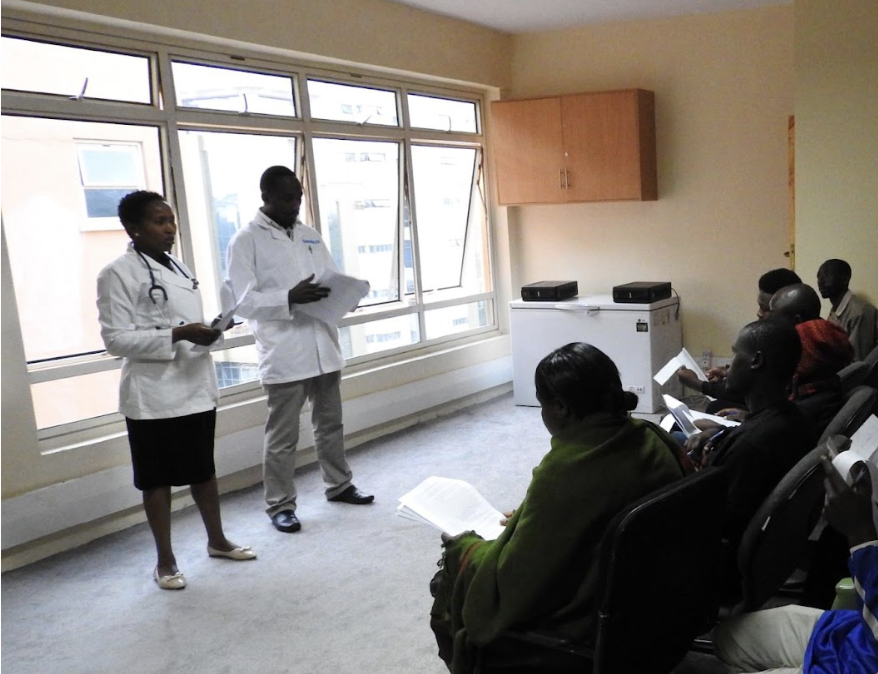
Here are three case studies that illustrate both the potential of behavioral science to improve people’s lives and some of the unique challenges of applying it in Global South settings.
Case study 1: Busara’s field surprise
Headquartered in Nairobi, the Busara Center has more than its share of hard-won lessons on what it’s like to conduct behavioral science in places like Kenya. Consider the following story from Busara’s early days (Jang et al., 2022), concerning its first-ever experiment in a field setting.
The year was 2013, and we studying the impact of stress on economic decision-making. To accomplish this, we needed a well-tested and well-validated manipulation to produce a bit of stress in the participants. Turning to the literature to see what other researchers were doing, we soon discovered a well-known research standard: the Trier Social Stress Test (Allen et al., 2017), which has been used for decades in literally hundreds of studies. We thought we had hit the jackpot.
In the most common version of the Trier Social Stress Test, participants are required to complete a mock interview-style speech in front of a panel of judges. What’s more, the judges are dressed formally, often in white lab coats to give participants a feeling of being put under a veritable laboratory microscope. In study after study, this type of procedure provokes a reliable and substantial amount of stress (Dickerson & Kemeny, 2004).
There was just one problem. The Kenyan participants were not stressed at all!
After discussing the matter with our Kenyan colleagues, we learned that the Trier Social Stress Test was miserably suited to the Kenyan context. Kenyans love giving speeches, even impromptu ones, and speeches are a relatively normal part of Kenyan life.

Moreover, the white lab coats that would conjure images of distant, judgmental scientists in the Western mind had a totally different association for Kenyans. Instead of scientists, Kenyan participants thought of the people they had usually seen wear white coats in the past: butchers. This prompted the remark from one of our participants: “Why are we being interviewed for a job by butchers?”
This incident illustrates a hard-won lesson: We cannot assume that what works in the United States and Europe will also work in the Global South. Even if the psychology that drives behavior is the same—which it may not be —the context can be radically different.
Doing behavioral science at Busara is therefore an exercise in consulting experts on the local context and synthesizing knowledge from those experts to develop an assessment of whether and how prior findings will apply in a new setting.
Case study 2: Save the Children medical incidence reporting
In late 2021, CUBIC launched a project focused on encouraging positive behavior change among Save the Children’s own staff, specifically our health workers working in refugee camps in Bangladesh and Rwanda (CUBIC, 2023). This project focused on encouraging reporting of medical incidents, which Save the Children defines as “events caused by clinical or pharmacy services, which led or could have led to unintended and/or unnecessary physical or psychological harm to a patient and/or staff.” Reporting of medical incidents is expected in health facilities around the world (to identify issues and prevent similar problems in the future). However, medical incidents are, in general, severely underreported.
For this project, we designed and tested different solutions in Bangladesh and Rwanda. In Bangladesh, a series of behaviorally informed SMS messages (and later emails) did not, unfortunately, lead to increased reporting of incidents in the global online system. However, in Rwanda, we introduced a simple paper form to help staff take the “first step” in reporting; this form also made reporting the default option since it was handed out at the end of each shift, and staff were expected to complete it on a daily basis. Compared with the 5-month period before the intervention was launched, when three incidents were reported, this form led to an approximately 10-fold increase in medical-incident reporting in the 5 months after its introduction, when 31 incidents were reported.
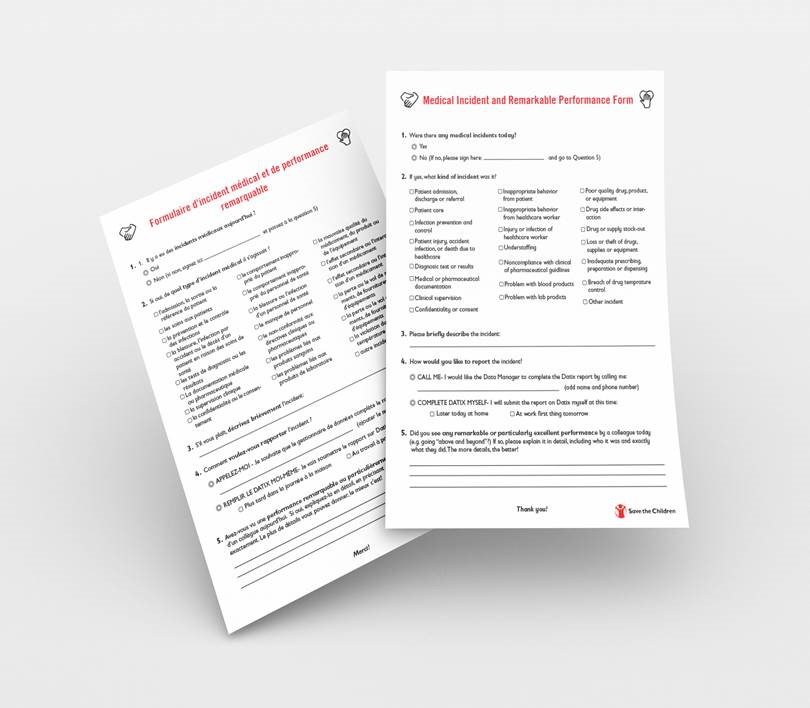
Because CUBIC implemented different interventions in Bangladesh and Rwanda, it is difficult to compare them. However, we speculate that the intervention in Rwanda—the simplified paper form—was more effective because it removed the need for staff to remember they had witnessed an incident and to take their own initiative to report it.
Instead, they only needed to respond to the form that was handed to them each day. In addition, one question on the form let staff choose if they wanted help from a trained, trusted colleague to submit the incident on the global online system or if they preferred to do it themselves. Submitting an incident on the global system is somewhat complex, so the provision of help made reporting easier for staff in Rwanda. By contrast, the Bangladesh approach of using behaviorally informed emails and SMS prompted staff to report incidents, but reporting was not their daily, required default. Similarly, staff in Bangladesh were prompted to go directly to the global online system and complete the form themselves; they did not have the option of getting help from a trusted colleague. Therefore, we speculate that staff in Bangladesh were reluctant to engage with the online system, which many perceive as complicated and confusing.
This dual-context project allowed CUBIC to explore multiple hypotheses and highlights the value of testing approaches and identifying specific mechanisms of change. The practical support identified as effective in Rwanda (use of defaults, ease, and routine) has since been proposed for further testing in Bangladesh and application to other contexts.
Case study 3: IRC social and emotional learning activities in North-East Nigeria
In 2021, the IRC aimed to improve social and emotional skills, such as emotional regulation and conflict resolution, in children affected by the decade-long conflict in North East Nigeria. Although the teaching of social emotional skills has provided benefits for vulnerable children in the Global North, recent attempts to introduce these approaches in humanitarian settings have had little or no impact on children’s social and emotional outcomes. One of the hypotheses was that the activities were too unfamiliar and difficult to implement in North East Nigeria. To improve the desirability and uptake of these activities, the IRC team complemented the use of applied behavioral science with a human-centered design approach, starting with a period of qualitative research followed by multiple rounds of iterative testing with teachers, parents, and local government (Bailey et al., 2021).
A behavioral science evidence review indicated that, among other interventions, SMS messages could be an effective strategy for encouraging uptake. Teachers said they would be excited to receive these types of SMS messages. In behavioral science projects in stable Global North contexts, we might have moved directly to an experiment or evaluation. However, we focused on contextualization and iterative testing because we did not have sufficient behavioral science evidence in similar contexts and therefore did not know how well behavioral interventions like SMS reminders would work in our context. We needed to learn what ideas are desirable and feasible for clients to use in their lived reality.
After the team tested the SMS messages over a period of several weeks, the findings were not as expected. Some teachers told us they had spent every night writing out each SMS message by hand onto paper or tried to have the messages printed for classroom use. They said it was important for a teacher in this community to have a book or physical reference material when teaching a class. In the end, we delivered core interventions on paper cards, but used SMS messages as complementary support, in addition to other interventions such as goal-setting prompts and gamification. As we incorporated more local feedback into the solutions from testing, we saw greater uptake of the interventions.
The end package of solutions was not only entirely contextualized, integrating both localized and evidence-backed content and framing, but included a set of locally tested behavioral solutions. After the prototyping was completed, a 6-month pilot study with 224 teachers found that after being exposed to the final package of interventions, teachers used the new activities for an average of 19 minutes a day, and more than 70% of teachers implemented the activities with high levels of quality and as intended. We believe other projects aiming to tackle complex challenges in low- and middle-income countries and humanitarian contexts would also benefit from using interdisciplinary, iterative, and systems-focused approaches in applying behavioral science to improve outcomes.
Risks and challenges of behavioral insights in the Global South
Behavioral science promises to enhance the effectiveness of existing programs and provide a framework for designing new ones. However, there are limitations to how behavioral science has been done in low- and middle-income countries (e.g., BI4Gov, 2020; Box-Steffensmeier et al., 2022; Chater & Loewenstein, 2022; Wambua et al., 2021). These include the tendency to overly focus on individual-level issues and solutions while overlooking broader, systemic causes; methodological issues related to program fidelity, scale-up, and implementation in development and humanitarian settings; the overrepresentation of WEIRD (Western, educated, industrialized, rich, and democratic) perspectives and evidence bases; and ethical concerns. Skeptics also argue that applied behavioral science is overhyped and may risk blowback resulting from unmet expectations and disappointing performance.
The following section details some of these specific concerns. We also describe how organizations like CUBIC, Busara, UNICEF, and IRC are modifying their approaches to applied behavioral science to respond to these concerns, often by taking a reflective and self-critical perspective and by bridging multiple disciplines, so that the strengths of one discipline can offset the limitations of another.
Individual focus: A poignant analysis by Chater and Lowenstein (2022) argues that one of behavioral science’s dominant paradigms—hyper focus on “quick-fix” individual-level solutions, rather than broader, systemic change—has been detrimental to the field. They posit this line of thinking has resulted in the phenomenon of “responsibilization,” in which individuals are blamed and made responsible for addressing systemic factors they are powerless to change (Giesler & Verusiu, 2014). For instance, using nudges and choice architecture to improve handwashing in a setting with limited clean water and poor sanitation is not only unlikely to achieve improvements in health outcomes, it may even lead program implementers to blame individuals for problems that ultimately have structural causes.
Chater and Lowenstein further claim that results from individual-level interventions have been “disappointingly modest” and, more concerningly, have guided many behavioral scientists to frame policy problems in individual, not systemic, terms. This individualistic focus may inadvertently devalue systemic actions such as regulation and taxation. As social scientists, anthropologists, public health specialists, and researchers from other disciplines have long argued, it is crucial that behavioral scientists contribute to reversing the individualistic paradigm. This can be done by identifying entry points and asking questions such as “where and how can behavioral science be used to nudge policymakers to invest in much-needed structural change?” and by using evidence from behavioral science interventions to expose systemic fallacies and thus push for system-level change.
Analyses of systems also extend to structures and systems of power. Power relations exist not only between practitioners/researchers and participants, but also between Global South and Global North institutions. These systems of power affect who gets a say, as well as why and how behavioral interventions are carried out. As a result, behavioral science researchers and practitioners working in low- and middle-income countries are also increasingly calling for both decolonizing research methodologies and harnessing international development approaches (Zavala, 2013). The focus on participatory approaches and human-centered design is a promising start, yet behavioral science could go beyond this and ensure that those conducting research embrace decolonizing practices when working with populations oppressed by colonial legacies (see Silan et al., 2021; Smith, 2021; Thambinathan & Kinsella, 2021). These practices also involve elevating the voices of marginalized populations and ensuring that issues such as ethics, equity, diversity, inclusion, and accessibility are considered throughout the life course of any behavioral science intervention. Indeed, the United Nations Secretary General (UNSG)’s Guidance Note on Behavioural Science recommends that it be “premised on commitments to human dignity, transparency and respect for ethical requirements” (UNSG, 2021).
Credibility related to replication, WEIRDness, and measurement: Issues of replication and generalizability that have affected much of the broader field also impact applied behavioral science. Consider the idea of stereotype threat, in which members of negatively stereotyped groups underperform on the very tasks they are stereotyped on. Although this idea has grown popular, both in social psychology and in public policy debates, contemporary investigations have challenged its replicability and generalizability to nonlaboratory settings (Shewach et al., 2019; Stafford, 2018). These findings present a challenge to behavioral interventions that use this as a foundation, especially in the Global South. Or consider the “watching-eyes effect”—the idea that images depicting eyes promote altruistic behavior (Pfattheicher & Keller, 2015). Despite this idea’s popularity, recent studies suggest the finding has poor replicability (Northover et al., 2017; Oda, 2019; Rotella et al., 2021), indicating that the strategy of depicting eyes would not improve programs even when used in combination with other interventions. Basing behavioral interventions on nonreplicable effects produces research waste that is ill-afforded in resource-limited settings. A literature of unreliable effects also pressures behavioral practitioners to spend more time carefully scrutinizing the evidence base of their behavioral interventions (for an example of a debate on nudging, see Szaszi et al., 2022).
About the Organizations
The Center for Utilizing Behavioral Insights for Children (CUBIC) uses behavioral science to create change for the world’s most marginalized children. Launched in 2020, CUBIC is the first embedded behavioral science team within a child-rights independent nongovernmental organization—a globally remote team of multilingual behavioral scientists who contribute to Save the Children projects across Asia, Africa, Europe, and Latin America. Projects have focused on vaccination uptake, positive parenting practices, education retention and teacher motivation, preventing hazardous child labor, and decreasing gender-based violence.
UNICEF Innocenti—Global Office of Research and Foresight tackles the questions of greatest importance for children, both current and emerging. It drives change through research and foresight on a wide range of child-rights issues, sparking global discourse and actively engaging young people in its work. UNICEF Innocenti is coleading the establishment of UNICEF’s Behavioral Insights Research and Design Laboratories (BIRD Labs), a multidisciplinary network focused on building capacity of governments and partners to harness evidence and methods from the behavioral sciences to secure results and rights for children.
The Busara Center for Behavioral Economics is one of the foremost behavioral science research organizations in the Global South. Its mission is to conduct behavioral science in the service of alleviating poverty. Headquartered in Nairobi, Kenya, Busara has completed more than 500 behavioral science projects with over 250 partners, ranging from governmental agencies, to multinational companies, to nongovernmental organizations. Its most distinctive features are the Busara Lab, the largest standing behavioral science lab in Africa, and its participant database, comprising over 100,000 research participants, allowing it to complete more than 130 research projects with 90-plus academic partners.
The International Rescue Committee (IRC) is a global humanitarian aid, relief, and development nongovernmental organization. The IRC responds to the world’s worst humanitarian crises and helps people whose lives and livelihoods are shattered by conflict and disaster to survive, recover, and gain control of their future. IRC began to formally engage with behavioral insights in 2017; its behavioral insights practice sits within the IRC’s research and innovation team, the Airbel Impact Lab.
Annecy Behavioral Science Lab (ABSL) is a startup that aims to bridge methodological best practices and open science to other research and applied behavioral science organizations. ABSL aims to organize the behavioral science community in tackling fundamental issues in behavioral science, including the replication crisis, measurement problems, data management, cross-cultural validation, and ethical open science especially as it affects vulnerable populations. Notable clients include NASA, More in Common, Morphit, and the Behavioral Insights Team—France.
Moreover, much of the evidence base for applied behavioral science still relies on participants and research products from WEIRD participants and researchers (IJzerman et al., 2021). This problem is insidious and affects various elements, from the way the research agenda is set to which measures are developed. For example, to understand if cognitive biases are universal, researchers should use tests that tap into the same cognitive processes for each culture. For instance, if one wishes to test for a bias based on the representativeness heuristic, a common assessment is the so-called “Linda Problem,” where participants judge how likely “Linda” is to be a feminist or a banker and a feminist. Linda is described as “… 31 years old, single, outspoken and very bright. She majored in philosophy. As a student, she was deeply concerned with issues of discrimination and social justice, and also participated in anti-nuclear demonstrations.” Participants in the United States judge Linda to be more likely to be both a bank teller and a feminist than judge her to be a bank teller, presumably because the description fits their stereotypes of feminists and does not fit their stereotype of bank tellers. However, Indians do not have the same stereotypes of either feminists or bank tellers—if they have any stereotypes of these groups at all. The “Linda Problem” therefore does not assess the representativeness heuristic very well in an Indian setting. Measures of other psychological and behavioral processes should be similarly contextualized to better measure the processes they assess. Laumas and colleagues (2020) describe one such process of contextualization to develop “Preeti,” an Indian version of “Linda” that is more recognizable and appropriate in the Indian context.
Ensuring fidelity: Another challenge in applying behavioral science to low- and middle-income countries is the implementation of randomized control trials (RCTs). To be meaningfully interpreted, RCTs require strict adherence to the research protocol. This can be very difficult in many of the contexts in which we work, given that local populations face issues such as political challenges, time and resource constraints, and urgent basic needs. This means that behavioral scientists must spend time a lot of time in dialogue with implementing partners to understand and overcome local difficulties, while also impressing upon them the reasons why trials must be conducted rigorously—such as the risks of serious implementation mistakes (“all this time and work will be for naught!”). To ensure fidelity, it’s also important to instate systems such as checklists, frequent calls and meetings, and in-person visits at key periods like the trial launch.
Establishing sustainability: Applied behavioral science often begins with smaller-scale field experiments to assess whether or not an intervention works before deciding to invest in taking an intervention to scale. However, international aid and development funding mechanisms often do not foster an environment that supports taking practices to scale, primarily because grant funding periods are usually limited to 1 to 2 years, or even shorter timeframes in humanitarian situations. This often results in highly compressed end-to-end behavioral science projects, with researchers conducting very rapid formative research, cocreating and agreeing interventions quickly, and then testing them—all in only a few months. For example, in one CUBIC/Save the Children project in the Philippines, CUBIC researchers had only 3 months to test a behaviorally informed SMS series to encourage vaccinations for pregnant women and infants, despite the fact that women are pregnant for 9 months and children’s routine vaccinations should be completed over a 2-year period.
Moreover, consider what happens after the 2-year project is done. The close of a project is the ideal time to refine, iterate, and scale our findings in CUBIC. Yet what usually happens is the grant period ends and there is no further funding for that refinement, iteration, and scaling. Many behavioral science projects in the Global South therefore risk stalling after the pilot stage.
Establishing the value of testing: One of the greatest challenges to the uptake of applied behavioral science in the Global South involves establishing the value of rigorous testing of “what works.” To illustrate this challenge, consider that most of the issues behavioral scientists hope to address in the Global South require more than “mere” nudges, as the issues have roots in poverty, challenging political contexts and resource-strapped government systems, cultural norms, and long-term and systemic inequities. However, it is impossible to avoid these difficult issues because they are what really matter to the families and communities we serve. As such, we end up tackling projects that have a high risk of failure, meaning we risk undermining our implementing partners’ and donors’ future appetites for behavioral science as an approach. Because of our focus on testing—often via experiments—we ourselves are likely to be the ones to confirm that our intervention didn’t work. Why should local government units collaborate with or develop behavioral insight teams that highlight their failures?
The international aid and development sectors have historically focused on research activities where failure is not apparent, such as people’s self-reported improvement from program baseline to endline. Control groups in randomized controlled designs, while on the increase, are still rare. The importance of the international and development sectors to applied behavioral science, combined with these sectors’ lack of experience with research designs where failure is a real possibility, poses a real challenge. Can we find a way to educate all important stakeholders about the importance of rigorous experiments, while at the same time managing their expectations about what will work in terms of generating positive results? Or will too many null results mean that partners and donors simply conclude that behavioral science doesn’t work?
Applying behavioral insights to emergency contexts: Although applied behavioral science is increasingly reflective of populations and contexts in low- and middle-income countries, humanitarian and emergency contexts are still a relatively unexplored frontier. For example, how would you implement a behavioral reminder intervention in Mali, where people may not have their own phones, may be illiterate, and do not have access to consistent phone signals? (See Lopez et al., 2022 for how this can be done.) In fact, from the insights learned, some of the most commonly cited behavioral interventions aimed at reminding populations (such as SMS reminders) would have failed or could have even backfired.
It is not easy to fill this critical evidence gap, as many of the challenges faced by behavioral science teams in low- and middle-income countries are amplified in places where the population is experiencing the consequences of conflict or displacement, such as Syria, Yemen, and South Sudan. For example, in a refugee context, behavioral science teams need to not only contextualize theories and evidence for multiple culturally diverse populations that may be temporarily displaced together, but also take into account challenges such as inaccessibility due to conflict, social instability, and the implementation constraints of populations on the move in a rapidly changing environment.
Data are also difficult to collect owing to logistical and ethical constraints. Interactions between data-collection teams and populations also need to be further examined in circumstances where communities may not feel safe providing honest information or authentic feedback to an organization providing them with critical, sometimes life-saving services. The power dynamics between provider and recipient can understandably exacerbate fears people may have of offending data-collection teams that represent lifelines.
Since well-known behavioral science strategies cannot be copied and pasted into these contexts, behavioral scientists must become more innovative as we respond to different needs and constraints. Although challenging, this also provides an opportunity: Applying behavioral science to diverse populations in different contexts can push the field to expand and test new forms of behavioral science interventions. For organizations like IRC, this has led to incorporating more interdisciplinary, adaptive, and iterative approaches into behavioral science projects, such as systems thinking and human-centered design.
Metascience and the future of behavioral insights in the Global South
Given both the promise and the risks of applying and learning from behavioral insights in the Global South, what does the future hold? One promising direction is the burgeoning field of behavioral science metaresearch (or metascience), the study of how to improve both the research and practice of behavioral science itself. Metaresearch includes initiatives in open science (UNESCO, 2021), which bolsters behavioral science’s credibility and allows the field to more easily “give back” research results to communities (Opensciency, n.d.). Metaresearch also promotes advances in locally contextualizing measures (Owsley et al., 2019) as well as the formation of large-scale collaborations that aim to better generalize behavioral insights globally (Moshontz et al., 2018). Organizations such as the Annecy Behavioral Science Lab and the Busara Center for Behavioral Economics have dedicated metaresearch teams charged with making headway into fundamental issues including replicability, measurement, and generalizability.
As the study of research processes, metaresearch evaluates which tools and approaches are useful for which problems. This pushes practitioners to ask how to better tackle complex behavioral challenges, such as addressing high rates of child malnutrition or reducing violence in low-resource settings. Addressing childhood malnutrition, for example, involves many different actors who influence one another, all operating at different levels in the system—from more proximal individuals, such as parents, to the decentralized healthcare system that itself operates from village to national level. These types of complex challenges may require applied behavioral science to center solutions around the needs and context of individuals’ lived reality, rapidly iterate testing and continuously revise interventions according to ongoing results, and map out the complex systems that influence individual behavior, including political and social institutions.
Improving the delivery of behavioral science solutions in low- and middle-income countries also means looking internally: Development professionals are as susceptible as anyone to cognitive biases and social influences, so behavioral insights are as applicable to their own behavior and organizations. CUBIC and UNICEF, for example, currently seek to identify internal “sludges,” which are the processes that make it inconvenient for individuals to make certain choices or engage in certain behaviors (the opposite of nudges). This may lead, for example, to the simplification of administrative processes, such as those for recruitment and procurement.
However, although much can be improved in terms of how applied behavioral science is conducted, the challenges of where the science takes place remain: in countries with deep-felt colonial legacies, unstable political situations, and systemic and resource inequities (Silan et al., 2021). This means certain problems endure: For example, can truly participatory and decolonial approaches rise beyond lip service without massive social restructuring? Furthermore, applied behavioral scientists need to continuously put in the time to partner with local implementing organizations to ensure sustainability and fidelity, as well as to establish the value of testing even as the local settings face social and political instability that may interrupt or even terminate organizational operations.
Although there are ample challenges, testing applied behavioral science in these contexts provides a unique opportunity to fill gaps in the evidence base about human behavior and design innovative solutions rather than relying on the same core suite of interventions. The Global South sets the stage for the future of behavioral insights.
Feedback on this article? Email [email protected] or login to comment. Interested in writing for us? Read our contributor guidelines.
Action Design Network. (n.d.). Behavioral teams directory. Retrieved 1 April, 2023, from https://www.action-design.org/behavioral-teams-directory
Adetula, A., Forscher, P. S., Basnight-Brown, D., Azouaghe, S., & IJzerman, H. (2022). Psychology should generalize from—not just to—Africa. Nature Reviews Psychology, 1(7), 370–371. https://doi.org/10.1038/s44159-022-00070-y
Afif, Z. (2017). “Nudge units”—where they came from and what they can do. World Bank Blogs. https://blogs.worldbank.org/developmenttalk/nudge-units-where-they-came-and-what-they-can-do
Allen, A. P., Kennedy, P. J., Dockray, S., Cryan, J. F., Dinan, T. G., & Clarke, G. (2017). The Trier Social Stress Test: Principles and practice. Neurobiology of Stress, 6, 113–126. https://doi.org/10.1016/j.ynstr.2016.11.001
Bailey, R., Raisch, N., Temko, S., Titus, B., Bautista, J., Eniola, T. O., & Jones, S. M. (2021). Innovations in social and emotional learning research and practice: building from evidence and applying behavioral insights to the design of a social and emotional learning intervention in northeast Nigeria. International Journal of Environmental Research and Public Health, 18(14), 7397. https://doi.org/10.3390/ijerph18147397
Balsom, S. (2019, April 30). UNICEF and the Ministry of Public Health are providing free vaccination to all children in Lebanon. UNICEF. https://www.unicef.org/lebanon/stories/unicef-and-ministry-public-health-are-providing-free-vaccination-all-children-lebanon
BI4Gov. (2020, January 28). Behavioural insights in developing countries: A series of conversations. https://bi4gov.org/updates/behavioural-insights-in-developing-countries-a-series-of-conversations
Box-Steffensmeier, J. M., Burgess, J., Corbetta, M., Crawford, K., Duflo, E., Fogarty, L., Gopnik, A., Hanafi, S., Herrero, M., Hong, Y. yi, Kameyama, Y., Lee, T. M. C., Leung, G. M., Nagin, D. S., Nobre, A. C., Nordentoft, M., Okbay, A., Perfors, A., Rival, L. M., … Wagner, C. (2022). The future of human behaviour research. Nature Human Behaviour, 6(1), 15–24. https://doi.org/10.1038/s41562-021-01275-6
Busara Center for Behavioral Economics. (2022). Improving digital loan repayment behaviors of small businesses. https://work.busaracenter.org/case-studies/Nigeria-PIU-GEEP.pdf
Center for Utilizing Behavioral Insights for Children. (2023) Medical Incident Reporting in DATIX: Using behavioral science and insights. Retrieved from: https://resourcecentre.savethechildren.net/pdf/Medical-Incidence-Reporting_-Rwanda-and-Bangladesh_-Behavioral-Insights-Research-2022.pdf/
Chater, N., & Loewenstein, G. (2022). The i-frame and the s-frame: How focusing on individual-level solutions has led behavioral public policy astray. Behavioral and Brain Sciences, 1–60. https://doi.org/10.1017/S0140525X22002023
Dickerson, S. S., & Kemeny, M. E. (2004). Acute stressors and cortisol responses: A theoretical integration and synthesis of laboratory research. Psychological Bulletin, 130(3), 355–391. https://doi.org/10.1037/0033-2909.130.3.355
Forscher, P. S., Basnight-Brown, D. M., Dutra, N., Adetula, A., Silan, M., Ijzerman, H. (2021, December 29). Psychological science needs the entire globe, part 3: Does psychological science deserve brilliant researchers from outside North America and Europe? APS Observer. https://www.psychologicalscience.org/observer/entire-globe-part-3
Giesler, M., & Veresiu, E. (2014). Creating the responsible consumer: Moralistic governance regimes and consumer subjectivity. Journal of Consumer Research, 41(3), 840–857. https://doi.org/10.1086/677842
Henrich, J., Heine, S. J., & Norenzayan, A. (2010a). Most people are not WEIRD. Nature, 466, 29. https://doi.org/10.1038/466029a
Henrich, J., Heine, S. J., & Norenzayan, A. (2010b). The weirdest people in the world? Behavioral and Brain Sciences, 33(2–3), 61–83. https://doi.org/10.1017/S0140525X0999152X
Haushofer, J., & Shapiro, J. (2016). The short-term impact of unconditional cash transfers to the poor: Experimental evidence from Kenya. Quarterly Journal of Economics, 131(4), 1973–2042. https://doi.org/10.1093/qje/qjw025
IJzerman, H., Dutra, N., Silan, M., Adetula, A., Brown, D. M. B., & Forscher, P. (2021, August 30). Psychological science needs the entire globe, part 1: The problem with U.S. dominance in psychological science. APS Observer. https://www.psychologicalscience.org/observer/global-psych-science
Jang, C., Saldanha, N., Singh, A., & Adhiambo, J. (2022). Implementing Behavioral Science Insights with Low-Income Populations in The Global South. In Mažar, N., & Soman, D. (Eds.). Behavioral Science in the Wild. University of Toronto Press.
Laumus, A., Owsley, N., & Haldea, P. (2020, July 2). How Preeti was born: A beginner’s guide to contextualizing behavioral measures. The Busara Blog. https://medium.com/busara-center-blog/how-preeti-was-born-af4583208fc9
Lopez, C. P., Titus, B., & Diarra, N. H. (2022). Improving the uptake of family mid-upper arm circumference screening in Mali. Field Exchange, 68, 23–26. https://www.ennonline.net/attachments/4697/FEX-68-FINAL_23-26.pdf
Moshontz, H., Campbell, L., Ebersole, C. R., Ijzerman, H., Urry, H. L., Forscher, P. S., Grahe, J. E., McCarthy, R. J., Musser, E. D., Antfolk, J., Castille, C. M., Evans, T. R., Fiedler, S., Flake, J. K., Forero, D. A., Janssen, S. M. J., Keene, J. R., Protzko, J., Aczel, B., … Chartier, C. R. (2018). The psychological science accelerator: Advancing psychology through a distributed collaborative network. Advances in Methods and Practices in Psychological Science, 1(4), 501–515. https://doi.org/10.1177/2515245918797607
Mughogho, W., Adhiambo, J., & Forscher, P. S. (2023). African researchers must be full participants in behavioural science research. Nature Human Behaviour, 7, 297–299. https://doi.org/10.1038/s41562-023-01536-6
Northover, S. B., Pedersen, W. C., Cohen, A. B., & Andrews, P. W. (2017). Effect of artificial surveillance cues on reported moral judgment: Experimental failures to replicate and two meta-analyses. Evolution and Human Behavior, 38(5), 561–571. https://doi.org/10.1016/j.evolhumbehav.2016.12.003
Oda, R. (2019). Is the watching-eye effect a fluke? Letters on Evolutionary Behavioral Science, 10(1), 4–6. https://lebs.hbesj.org/index.php/lebs/article/download/318/259
Opensciency. (n.d.) Lesson 2: The why. Benefits and challenges of responsible open science: Why does it matter? Retrieved 6 April, 2023, from https://github.com/opensciency/sprint-content/blob/main/ethos-of-open/lesson2-benefits-challenges-of-open.md
Owsley, N., Adhiambo, J., Owelle, E., Ngina, I., & Amanela, S. (2019, February 13). Off the record #3: Are cognitive biases universal across cultures? The Bursara Blog. https://medium.com/busara-center-blog/are-cognitive-biases-universal-across-cultures-6b8f7791eb6c
Pfattheicher, S., & Keller, J. (2015). The watching eyes phenomenon: The role of a sense of being seen and public self-awareness. European Journal of Social Psychology, 45(5), 560–566. https://doi.org/10.1002/ejsp.2122
Reimann, K. D. (2005). Up to no good? Recent critics and critiques of NGOs. In Subcontracting peace (pp. 37-53). Routledge. Retrieved from https://www.taylorfrancis.com/chapters/edit/10.4324/9781351148405-3/good-recent-critics-critiques-ngos-kim-reimann
Rotella, A., Sparks, A. M., Mishra, S., & Barclay, P. (2021). No effect of ‘watching eyes’: An attempted replication and extension investigating individual differences. PLoS ONE, 16, Article e0255531. https://doi.org/10.1371/journal.pone.0255531
Shewach, O. R., Sackett, P. R., & Quint, S. (2019). Stereotype threat effects in settings with features likely versus unlikely in operational test settings: a meta-analysis. Journal of Applied Psychology. 104(12), 1514–1534. https://doi.org/10.1037/apl0000420
Silan, M., Adetula, A., Basnight-Brown, D. M., Forscher, P. S., Dutra, N., Ijzerman, H. (2021, October 26). Psychological science needs the entire globe, part 2: Let’s talk about the “C” word: Colonialism and the challenges of psychological science in the developing world. APS Observer. https://www.psychologicalscience.org/observer/psychological-science-needs-the-entire-globe-part-2
Smith, L. (2021). Decolonial Research Methods: Resisting Coloniality in Academic Knowledge Production (Webinar 2). Retrieved from: https://eprints.ncrm.ac.uk/id/eprint/4488/1/Linda_T_Smith_Decolonial_Research_Methods.pdf
Stafford, T. (2018). Female chess players outperform expectations when playing men. Psychological Science, 29(3), 429–436. https://doi.org/10.1177/0956797617736887
Szaszi, B., Higney, A., Charlton, A., Gelman, A., Ziano, I., Aczel, B., Goldstein, D. G., Yeager, D. S., & Tipton, E. (2022). No reason to expect large and consistent effects of nudge interventions. Proceedings of the National Academy of Sciences of the United States of America, 119(31), Article e2200732119. https://doi.org/10.1073/pnas.2200732119
Thambinathan, V., & Kinsella, E. A. (2021). Decolonizing methodologies in qualitative research: Creating spaces for transformative praxis. International Journal of Qualitative Methods, 20. https://doi.org/10.1177/16094069211014766
UNESCO. (2021). UNESCO recommendation on open science. Program and meeting document. SC-PCB-SPP/2021/OS/UROS, 10.54677/MNMH8546. https://unesdoc.unesco.org/ark:/48223/pf0000379949
UNICEF. (2022, October 14). DepEd, DOH, UNICEF, WHO and Marikina City promote handwashing to create safe schools and communities. https://www.unicef.org/philippines/press-releases/deped-doh-unicef-who-and-marikina-city-promote-handwashing-create-safe-schools-and
United Nations Secretary General. (2021). Guidance note on behavioral science. https://www.un.org/en/content/behaviouralscience
Wambua, J. M., Owsley, N. C., Wein, T., & Busara Lab, B. (2021, October 28). Participant voice first: the Busara research agenda on ethical research in the Global South. https://doi.org/10.31222/osf.io/kvf3a
Wilton, K., Shiori-Clark, M., & Murphy, K. (2017). Parenting in displacement: Adapting Vroom for displaced Syrian families. International Rescue Committee. https://www.rescue.org/sites/default/files/document/1554/parentingindisplacementadaptingvroomfordisplacedsyrianfamiliescasestudy.pdf
Zavala, M. (2013). What do we mean by decolonizing research strategies ? Lessons from decolonizing, Indigenous research projects in New Zealand and Latin America. Decolonization: Indigeneity, Education & Society, 2(1), 55–71.


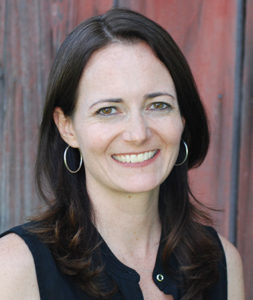

 Patrick Forscher
Patrick Forscher Floriza Gennari
Floriza Gennari Benjamin Hickler
Benjamin Hickler Moreen Terer
Moreen Terer
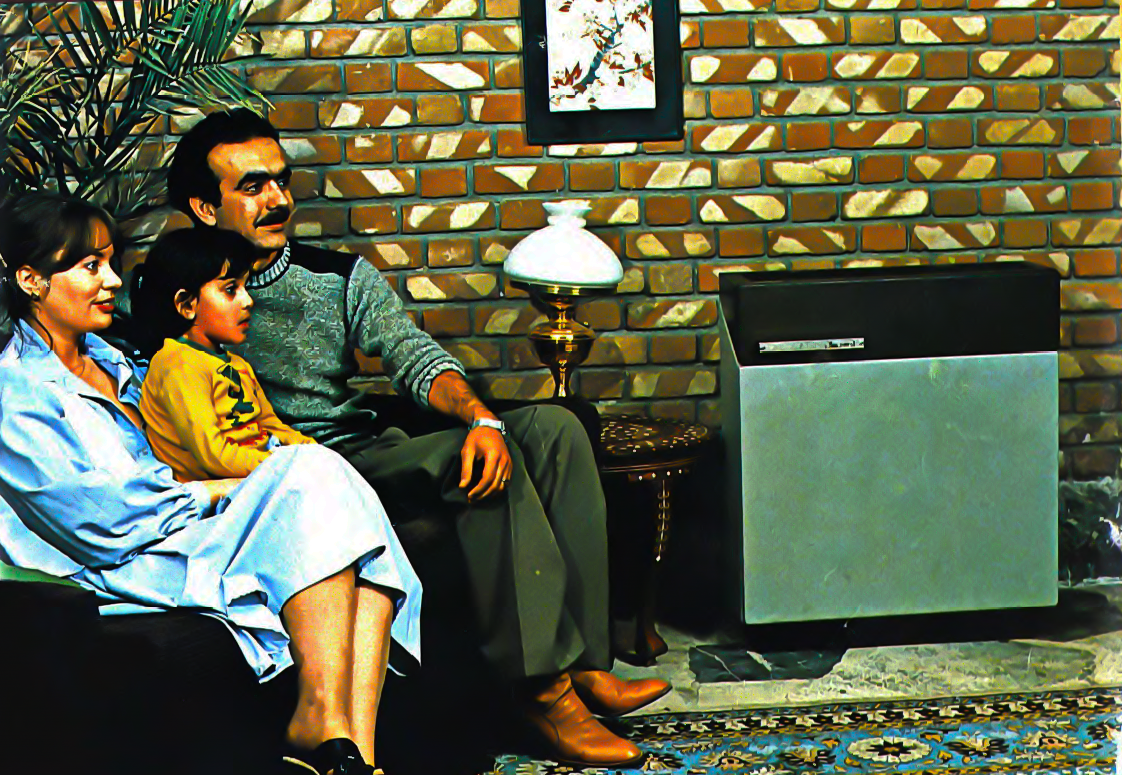


APS regularly opens certain online articles for discussion on our website. Effective February 2021, you must be a logged-in APS member to post comments. By posting a comment, you agree to our Community Guidelines and the display of your profile information, including your name and affiliation. Any opinions, findings, conclusions, or recommendations present in article comments are those of the writers and do not necessarily reflect the views of APS or the article’s author. For more information, please see our Community Guidelines.
Please login with your APS account to comment.